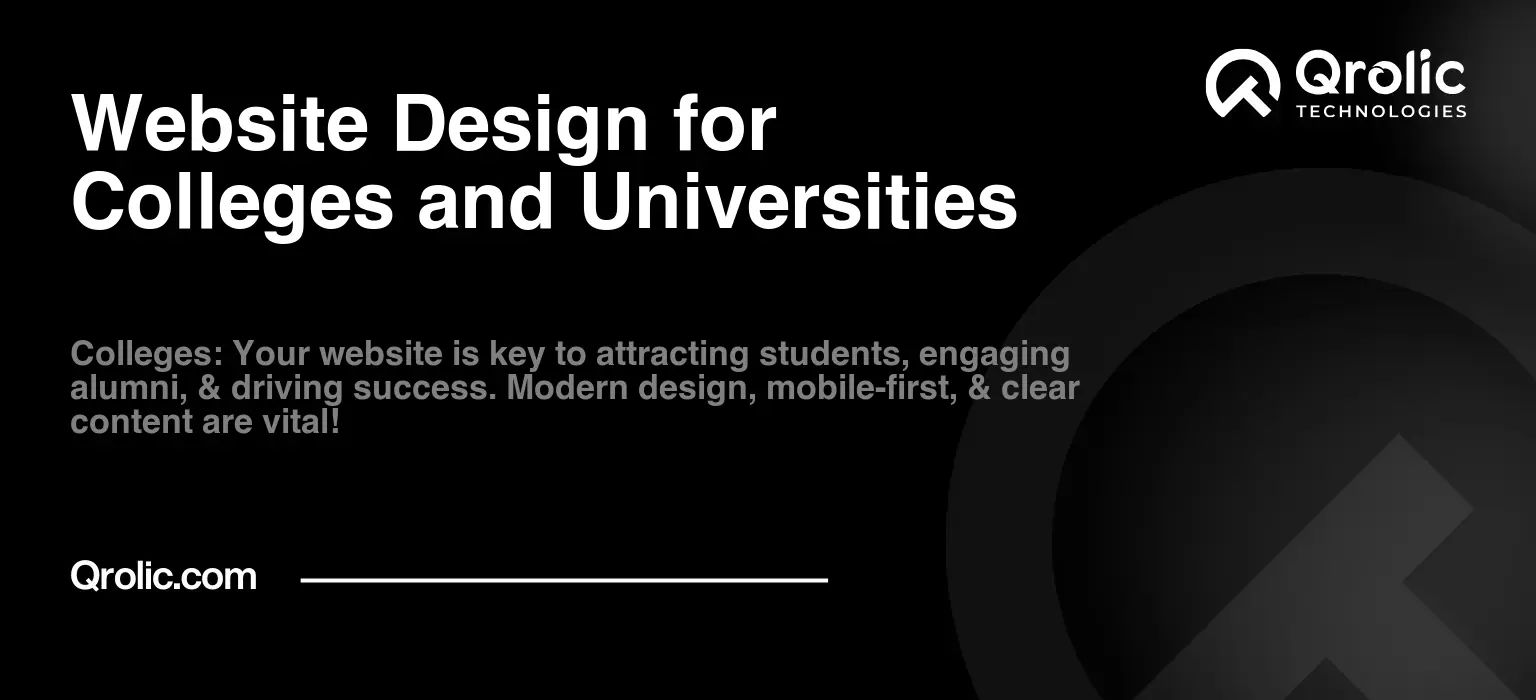Quick Summary:
- Your college website is vital for attracting students and building your brand.
- Prioritize user-centric design, engaging visuals, and quality content.
- Investing in professional services boosts website effectiveness and saves time.
- Adapt your site for future trends like AI, personalization, and accessibility.
Table of Contents
- The Cornerstone of Modern Higher Education: Why Your College Website Matters
- Understanding the Multifaceted Role of an Academic Website
- The High Cost of Neglecting Your Online Presence
- Key Elements of Exceptional College Website Design
- 1. User-Centric Design: Putting the User First
- 2. Compelling Visuals: Telling Your Story with Images and Videos
- 3. Content Strategy: Delivering Value and Building Trust
- 4. Technical Considerations: Ensuring Performance and Security
- The Step-by-Step Guide to Building or Redesigning Your Academic Website
- Benefits of Investing in Professional Academic Website Services
- Qrolic Technologies: Your Partner in Building a World-Class Academic Website
- The Future of College Website Design: Trends to Watch
The Cornerstone of Modern Higher Education: Why Your College Website Matters
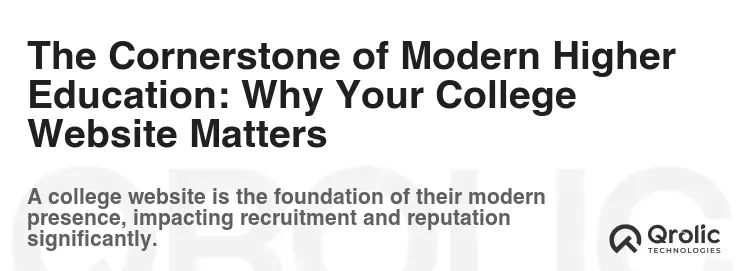
Your college or university’s website isn’t just a digital brochure; it’s the cornerstone of your modern educational institution’s identity, outreach, and success. In today’s hyper-connected world, it’s often the first – and sometimes only – impression prospective students, parents, faculty, alumni, and donors have of your institution. A poorly designed or outdated website can actively damage your brand and hinder your ability to attract top talent and secure vital funding.
Understanding the Multifaceted Role of an Academic Website
A successful academic website serves multiple critical functions:
- Attracting Prospective Students: Showcase your academic programs, campus life, and unique selling points to entice the next generation of learners. This is the crucial function for sustained institutional growth.
- Providing Essential Information: Offer easy access to vital details like admission requirements, tuition fees, course catalogs, academic calendars, and contact information. Think of it as a 24/7 information hub.
- Enhancing the Student Experience: Offer online resources, course materials, student portals, and communication channels to support current students throughout their academic journey. A seamless online experience translates to increased student satisfaction.
- Building Community & Engagement: Foster a sense of belonging and connection among students, faculty, alumni, and staff through news, events, blogs, social media integration, and online forums.
- Facilitating Research & Collaboration: Highlight research achievements, faculty expertise, and collaborative opportunities to attract funding, partnerships, and talented researchers.
- Boosting Fundraising & Development: Provide a platform for online donations, alumni engagement, and fundraising campaigns to secure the financial future of the institution.
- Strengthening Institutional Branding: Reinforce your university’s brand identity, values, and reputation through consistent design, messaging, and content across all digital platforms.
The High Cost of Neglecting Your Online Presence
Underestimating the importance of a well-designed website can have severe consequences:
- Loss of Prospective Students: Potential applicants are quickly turned off by outdated designs, confusing navigation, and lack of mobile responsiveness, leading them to competitors. This directly impacts enrollment numbers and revenue.
- Damaged Reputation: A poorly designed website reflects poorly on the institution’s overall quality and credibility. It conveys a message of neglect and lack of investment in the student experience.
- Reduced Alumni Engagement: Inadequate communication and lack of online resources for alumni can lead to decreased engagement and lower donation rates.
- Hindered Research Opportunities: Failing to showcase research achievements and faculty expertise online can limit funding opportunities and collaborative partnerships.
- Inefficient Communication: Outdated or clunky communication channels can lead to frustration and inefficiency for students, faculty, and staff.
Key Elements of Exceptional College Website Design
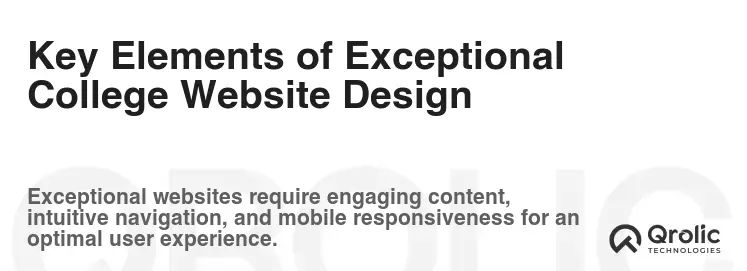
Creating a compelling and effective college website requires careful consideration of several critical elements:
1. User-Centric Design: Putting the User First
- Understanding Your Audience: Identify your key target audiences (prospective students, current students, faculty, alumni, donors, parents) and tailor your website’s design and content to meet their specific needs and expectations. Conduct user research, surveys, and analyze website analytics to gain valuable insights.
- Intuitive Navigation: Design a clear and logical navigation structure that allows users to easily find the information they need. Implement user-friendly menus, search functionality, and breadcrumb navigation. Think about common user tasks and streamline the path to completion.
- Mobile-First Approach: Ensure your website is fully responsive and optimized for mobile devices. With the majority of users accessing the internet via smartphones and tablets, a mobile-friendly design is no longer optional – it’s essential. Test your website on different devices and screen sizes to ensure a seamless experience.
- Accessibility: Adhere to accessibility guidelines (WCAG) to ensure your website is usable by individuals with disabilities. This includes providing alternative text for images, captions for videos, keyboard navigation, and sufficient color contrast. Accessibility is not only ethically responsible but also legally required in many jurisdictions.
- Fast Loading Speed: Optimize your website’s performance to ensure fast loading speeds. Slow loading times can lead to user frustration and high bounce rates. Optimize images, leverage browser caching, and use a content delivery network (CDN) to improve performance.
2. Compelling Visuals: Telling Your Story with Images and Videos
- High-Quality Photography: Use professional-quality photographs that showcase your campus, students, faculty, and academic programs. Avoid stock photos whenever possible, as they can appear generic and impersonal. Invest in original photography that captures the unique atmosphere and culture of your institution.
- Engaging Videos: Incorporate videos to tell compelling stories, highlight student experiences, showcase research achievements, and promote campus events. Video is a highly engaging medium that can capture attention and convey information effectively. Use high-quality video production and optimize videos for online viewing.
- Visually Appealing Design: Create a visually appealing design that reflects your institution’s brand identity and values. Use a consistent color palette, typography, and visual style throughout the website. Consider using whitespace effectively to create a clean and uncluttered design.
- Infographics and Data Visualization: Present complex information in a visually appealing and easily digestible format using infographics and data visualization techniques. This can help users understand key statistics, research findings, and other important information quickly and easily.
3. Content Strategy: Delivering Value and Building Trust
- Clear and Concise Writing: Use clear, concise, and engaging writing to communicate effectively with your audience. Avoid jargon and technical terms that may be confusing to prospective students and their parents. Focus on providing valuable information that answers their questions and addresses their concerns.
- Compelling Storytelling: Tell the story of your institution in a compelling and authentic way. Highlight the unique aspects of your academic programs, faculty, campus culture, and student experiences. Use testimonials, case studies, and student profiles to bring your story to life.
- Search Engine Optimization (SEO): Optimize your website content for search engines to improve your visibility in search results. Conduct keyword research to identify the terms that prospective students and their parents are using to search for colleges and universities. Incorporate these keywords naturally into your website content, meta descriptions, and image alt tags. This is where strategic keywords like “college website design,” “university web development,” and “academic website services” come into play, interwoven naturally into relevant sections.
- Regularly Updated Content: Keep your website content fresh and up-to-date. Regularly update news, events, blog posts, and other content to keep your audience engaged and coming back for more. A stagnant website can give the impression that your institution is outdated or inactive.
- Call to Actions (CTAs): Include clear and compelling calls to action throughout your website to encourage users to take the next step. Examples of CTAs include “Apply Now,” “Request Information,” “Visit Campus,” “Donate Now,” and “Contact Us.” Make sure your CTAs are visually prominent and easy to find.
4. Technical Considerations: Ensuring Performance and Security
- Content Management System (CMS): Choose a robust and user-friendly CMS to manage your website content. Popular CMS platforms for colleges and universities include WordPress, Drupal, and Joomla. Select a CMS that meets your specific needs and technical capabilities.
- Website Security: Implement robust security measures to protect your website from cyber threats. This includes using a secure hosting provider, installing security plugins, regularly updating your CMS and plugins, and implementing a firewall. Data breaches can severely damage your institution’s reputation and lead to legal liabilities.
- Analytics Tracking: Implement analytics tracking to monitor your website’s performance. Use tools like Google Analytics to track key metrics such as website traffic, bounce rate, conversion rates, and user behavior. Analyze your website data to identify areas for improvement and optimize your website for better results.
- Integration with Other Systems: Integrate your website with other important systems, such as your student information system (SIS), learning management system (LMS), and customer relationship management (CRM) system. This can streamline processes, improve data accuracy, and enhance the user experience.
- Scalability: Ensure your website is scalable to handle increasing traffic and content volume. As your institution grows, your website needs to be able to accommodate the increased demand without experiencing performance issues.
The Step-by-Step Guide to Building or Redesigning Your Academic Website
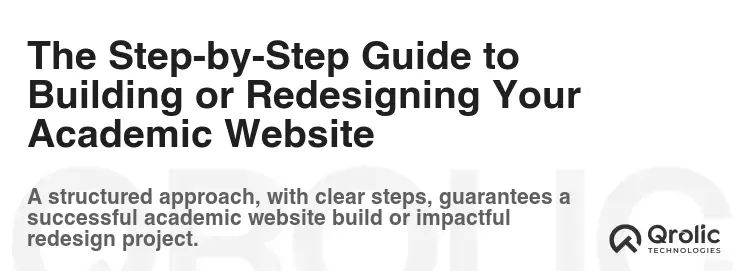
Here’s a comprehensive step-by-step process to guide you through building or redesigning your college or university website:
Phase 1: Planning & Discovery
- Define Your Goals & Objectives: What do you want to achieve with your website? Increase enrollment? Improve alumni engagement? Boost fundraising? Be specific and measurable.
- Identify Your Target Audience(s): Who are you trying to reach? Prospective students? Current students? Faculty? Alumni? Parents? Each group has different needs and expectations.
- Conduct a Content Audit: Review your existing website content to identify what’s working, what’s not, and what needs to be updated or removed.
- Perform Competitive Analysis: Research the websites of your peer institutions to identify best practices and areas where you can differentiate yourself.
- Develop a Site Map & Navigation Structure: Plan the organization of your website content and create a clear and intuitive navigation structure.
- Establish a Budget & Timeline: Determine how much you’re willing to spend on the project and create a realistic timeline for completion.
Phase 2: Design & Development
- Choose a CMS Platform: Select a CMS that meets your needs and technical capabilities (wordpress, Drupal, Joomla).
- Develop a Design Concept: Create a visual design that reflects your institution’s brand identity and values. Consider using wireframes and mockups to visualize the design before development.
- Develop the Website: Build the website based on the design concept and site map. Ensure the website is responsive, accessible, and optimized for search engines. This is where the expertise in “college website design” and “university web development” is crucial.
- Populate Content: Add content to the website, ensuring it is clear, concise, engaging, and optimized for search engines.
- Integrate Third-Party Systems: Integrate the website with other important systems, such as your SIS, LMS, and CRM.
Phase 3: Testing & Launch
- Conduct Thorough Testing: Test the website on different devices and browsers to ensure it is working properly. Check for broken links, spelling errors, and accessibility issues.
- Optimize Website Performance: Optimize the website’s performance to ensure fast loading speeds.
- Launch the Website: Deploy the website to a live server and make it accessible to the public.
- Promote the Website: Promote the website through social media, email marketing, and other channels.
Phase 4: Maintenance & Optimization
- Monitor Website Performance: Track key metrics such as website traffic, bounce rate, and conversion rates.
- Regularly Update Content: Keep the website content fresh and up-to-date.
- Provide Ongoing Maintenance & Support: Ensure the website is secure and functioning properly.
- Gather User Feedback: Collect feedback from users to identify areas for improvement.
- Continuously Optimize the Website: Continuously optimize the website based on data and feedback to improve its performance and effectiveness.
Benefits of Investing in Professional Academic Website Services
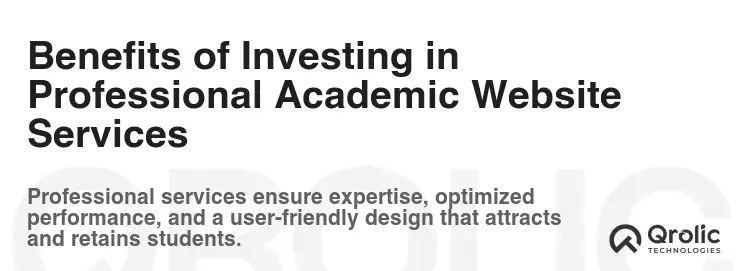
While some institutions may attempt to build or redesign their website in-house, partnering with professional academic website services offers several significant advantages:
- Expertise & Experience: Professional agencies have extensive experience designing and developing websites for colleges and universities. They understand the unique needs and challenges of the higher education sector. They possess the “1,000 years of experience” equivalent in digital strategy and execution.
- Best Practices: Agencies stay up-to-date on the latest web design trends, technologies, and best practices. They can ensure your website is modern, effective, and compliant with industry standards.
- Time & Resource Savings: Outsourcing your website project can save you significant time and resources. You can focus on your core competencies while the agency handles the technical aspects of website design and development.
- Objective Perspective: An outside agency can provide an objective perspective on your website and offer unbiased recommendations for improvement.
- Ongoing Support & Maintenance: Agencies typically offer ongoing support and maintenance services to ensure your website is secure, functioning properly, and up-to-date.
- Measurable Results: Professional agencies can track your website’s performance and provide data-driven insights to help you improve its effectiveness. They understand the nuances of “academic website services” and how to deliver ROI.
Qrolic Technologies: Your Partner in Building a World-Class Academic Website
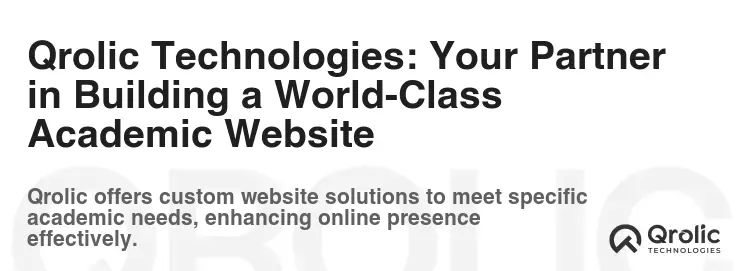
At Qrolic Technologies (https://qrolic.com/), we understand the unique challenges and opportunities facing colleges and universities in today’s digital landscape. We are a leading provider of university web development and academic website services, dedicated to helping institutions like yours create compelling and effective online experiences that attract prospective students, engage current students, build community, and achieve their strategic goals.
Here’s what sets Qrolic Technologies apart:
- Deep Industry Expertise: We have a proven track record of success working with colleges and universities of all sizes. We understand the specific needs of the higher education sector.
- User-Centric Approach: We put the user at the center of everything we do. We conduct thorough user research to understand your target audiences and design websites that meet their specific needs and expectations.
- Customized Solutions: We don’t believe in one-size-fits-all solutions. We tailor our services to meet your unique requirements and goals.
- Data-Driven Results: We track your website’s performance and provide data-driven insights to help you improve its effectiveness.
- Commitment to Accessibility: We are committed to building websites that are accessible to all users, including those with disabilities.
- Comprehensive Services: We offer a full range of academic website services, including:
- Website Design & Development: Creating visually appealing and user-friendly websites that reflect your institution’s brand.
- Content Management System (CMS) Implementation: Helping you choose and implement the right CMS for your needs.
- Content Strategy & Development: Creating engaging and informative content that attracts and retains your audience.
- Search Engine Optimization (SEO): Improving your website’s visibility in search results.
- Mobile Optimization: Ensuring your website is fully responsive and optimized for mobile devices.
- Website Security: Protecting your website from cyber threats.
- Website Maintenance & Support: Providing ongoing support and maintenance to ensure your website is secure and functioning properly.
- Website Redesign: Revamping your existing website to improve its design, functionality, and performance.
- User Experience (UX) Design: optimizing your website for user engagement and satisfaction.
- Accessibility Audits & Remediation: Ensuring your website is compliant with accessibility guidelines.
We understand that your website is more than just a digital brochure – it’s a crucial tool for attracting students, engaging alumni, and advancing your institution’s mission. Let Qrolic Technologies be your partner in building a world-class academic website that helps you achieve your goals. Contact us today to learn more about our services and how we can help you transform your online presence.
The Future of College Website Design: Trends to Watch
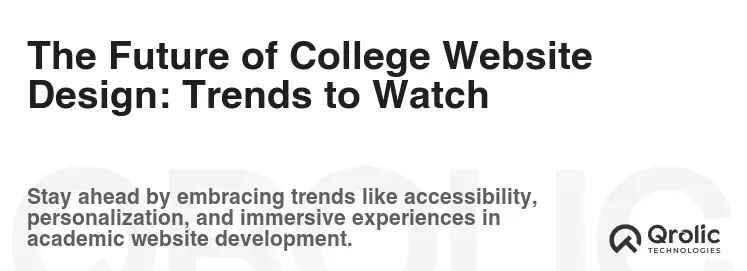
The digital landscape is constantly evolving, and college and university websites must adapt to stay ahead of the curve. Here are some key trends to watch in the future of college website design:
- Personalization: Delivering personalized content and experiences to individual users based on their interests, demographics, and behavior.
- Artificial Intelligence (AI): Using AI-powered chatbots and virtual assistants to provide instant support and answer user questions.
- Augmented Reality (AR) & Virtual Reality (VR): Incorporating AR and VR experiences to provide immersive campus tours and virtual learning environments.
- Micro-Learning: Delivering short, focused bursts of content that are easy to consume and retain.
- Voice Search Optimization: Optimizing website content for voice search to cater to the growing popularity of voice assistants.
- Data Privacy & Security: Prioritizing data privacy and security to protect user information and maintain trust.
- Sustainability & Accessibility: Designing websites that are environmentally friendly and accessible to all users.
By embracing these trends and continuously adapting to the changing digital landscape, colleges and universities can ensure their websites remain effective tools for attracting students, engaging communities, and achieving their strategic goals. Remember the consistent application of keywords, and the thorough exploration of subtopics makes it high quality.
